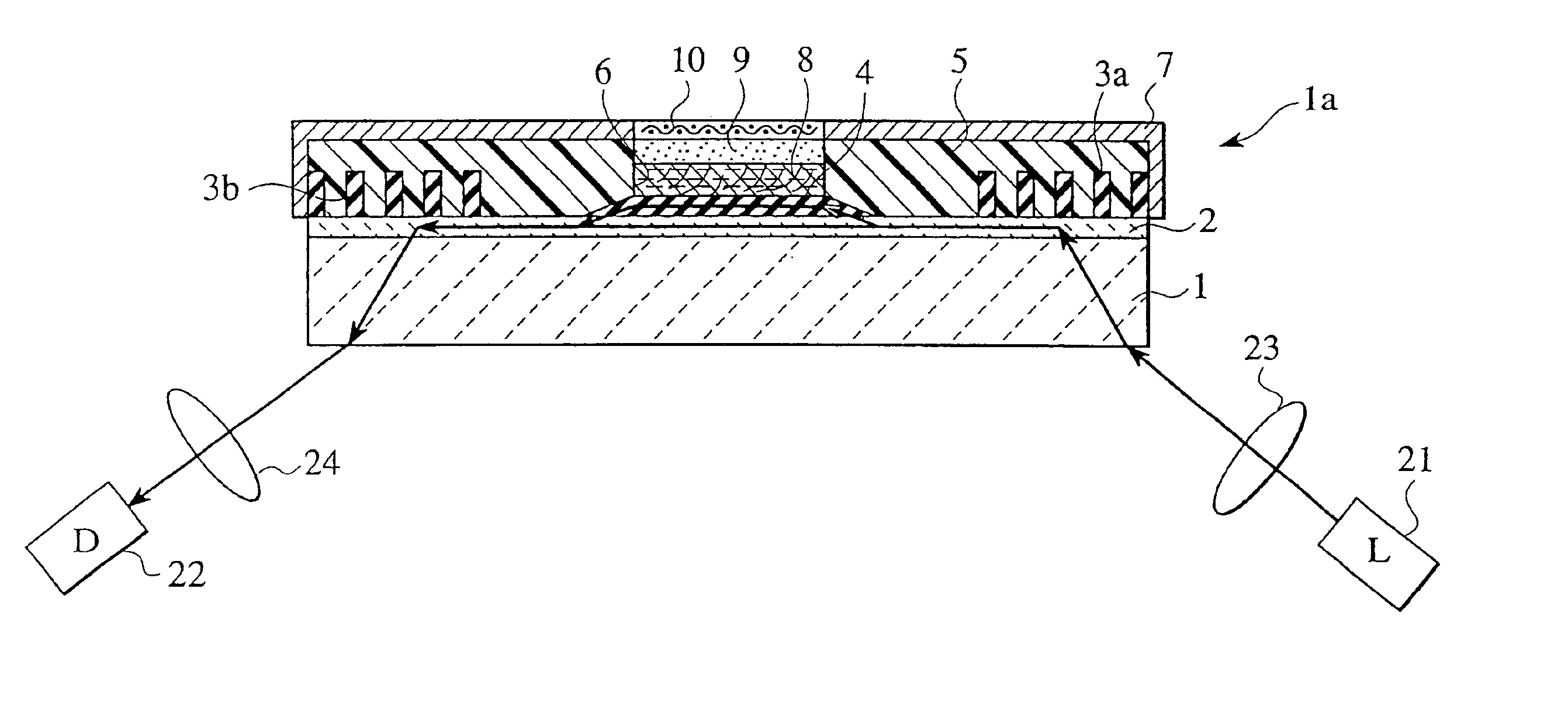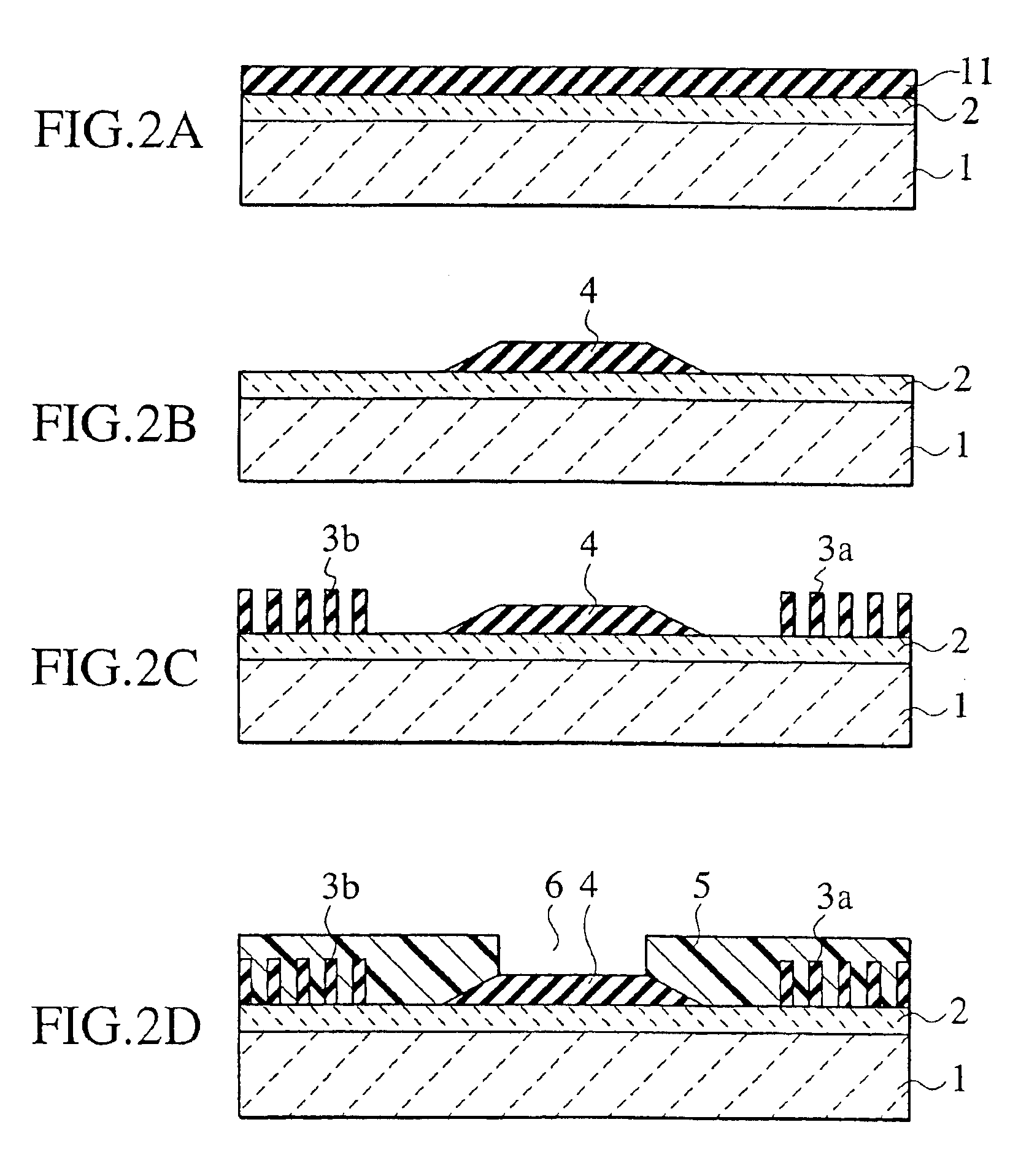Optical waveguide sensor, device, system and method for glucose measurement
a technology of optical waveguide and glucose sensor, which is applied in the field of optical waveguide type glucose sensor, can solve the problems of limiting the sensitivity of detecting the change in the quantity of evanescent wave generated, and the film structure of the optical waveguide layer is not suitable for analysis of the extremely small amount of biomolecules contained in blood
- Summary
- Abstract
- Description
- Claims
- Application Information
AI Technical Summary
Benefits of technology
Problems solved by technology
Method used
Image
Examples
first embodiment
[0035]In an optical waveguide type glucose sensor 1a according to the first embodiment of the present invention, as illustrated in FIG. 1, a substrate 1 which is made of glass, for example, and a first optical waveguide layer 2 having a refractive index higher than that of the substrate 1 and being placed on the surface of the substrate 1, are formed. In addition, a grating 3a located at an entrance portion (hereinafter the entrance grating) and another grating 3b located at an exit portion (hereinafter the exit grating) have refractive indexes higher than that of the first optical waveguide layer 2, and both gratings are respectively formed on the surface in the vicinities of both ends of the first optical waveguide layer 2. Moreover, the second optical waveguide layer 4 in which a circumference is tapered in shape and has a higher refractive index than the first optical waveguide layer 2 and is formed on a part of the first optical waveguide layer 2, is located between the entranc...
second embodiment
[0059]The optical waveguide type glucose sensor 1b illustrated in FIG. 4 has a structure in which an immobilized coloring reagent layer 13 is formed on the second optical waveguide layer 4 and an immobilized enzyme layer 14 is formed on the immobilized coloring reagent layer 13. In short, the optical waveguide type glucose sensor 1b shown in FIG. 4 has a structure in which the functioning layer 8 in the previously mentioned first embodiment is separated into two layers, the immobilized coloring reagent layer 13 and the immobilized enzyme layer 14.
[0060]The immobilized coloring reagent layer 13 is formed by fixing the coloring reagent to the surface of the second optical waveguide layer 4 by the application of silane coupling agent or cross-linking polymer, wherein examples of the coloring reagent are dipotassium N. N-bis(2-hydroxy-3-sulfopropyl)tolidine salt or 3,3′,5,5′-tetramethylbenzidine, an example of the silane coupling agent is aminoalkyltrimethoxysilane, and an example of th...
third embodiment
[0064]An optical waveguide type glucose sensor 1c illustrated in FIG. 5 has a second optical waveguide layer 15 on the first optical waveguide layer 2 between the entrance grating 3a and the exit grating 3b. The second optical waveguide layer 15 is formed by an electro-conductive material having a refractive index higher than that of the first optical waveguide layer 2 such as stannum oxide (SnO2) and ITO, and a desired electric field (for example, a pulsed electric field) is applied to the second optical waveguide layer 15.
[0065]As a modification of wiring shown in FIG. 3, the cathode of an electric source 102 is wired to the second optical waveguide layer 15, and the anode of the electric source 102 is wired to an electrode plate 101 in the optical waveguide type glucose sensor 1c illustrated in FIG. 5. Then, the analyte 100, for example, a part of a human skin, is placed to contact with the portion of the porous film 9 provided on the functioning layer 8 containing the enzyme and...
PUM
| Property | Measurement | Unit |
|---|---|---|
| wave length | aaaaa | aaaaa |
| refractive index | aaaaa | aaaaa |
| electro-conductive | aaaaa | aaaaa |
Abstract
Description
Claims
Application Information
 Login to View More
Login to View More - R&D
- Intellectual Property
- Life Sciences
- Materials
- Tech Scout
- Unparalleled Data Quality
- Higher Quality Content
- 60% Fewer Hallucinations
Browse by: Latest US Patents, China's latest patents, Technical Efficacy Thesaurus, Application Domain, Technology Topic, Popular Technical Reports.
© 2025 PatSnap. All rights reserved.Legal|Privacy policy|Modern Slavery Act Transparency Statement|Sitemap|About US| Contact US: help@patsnap.com



